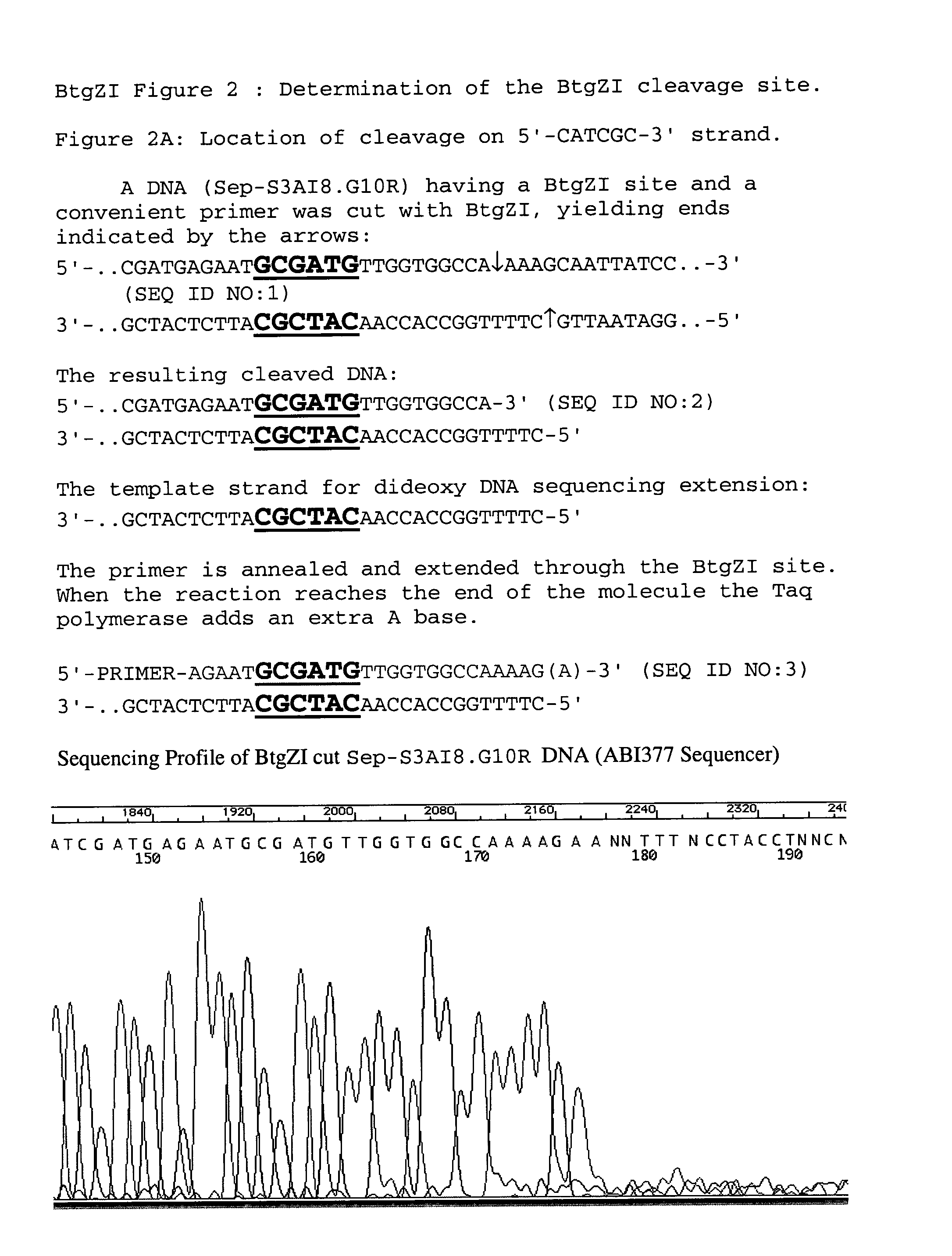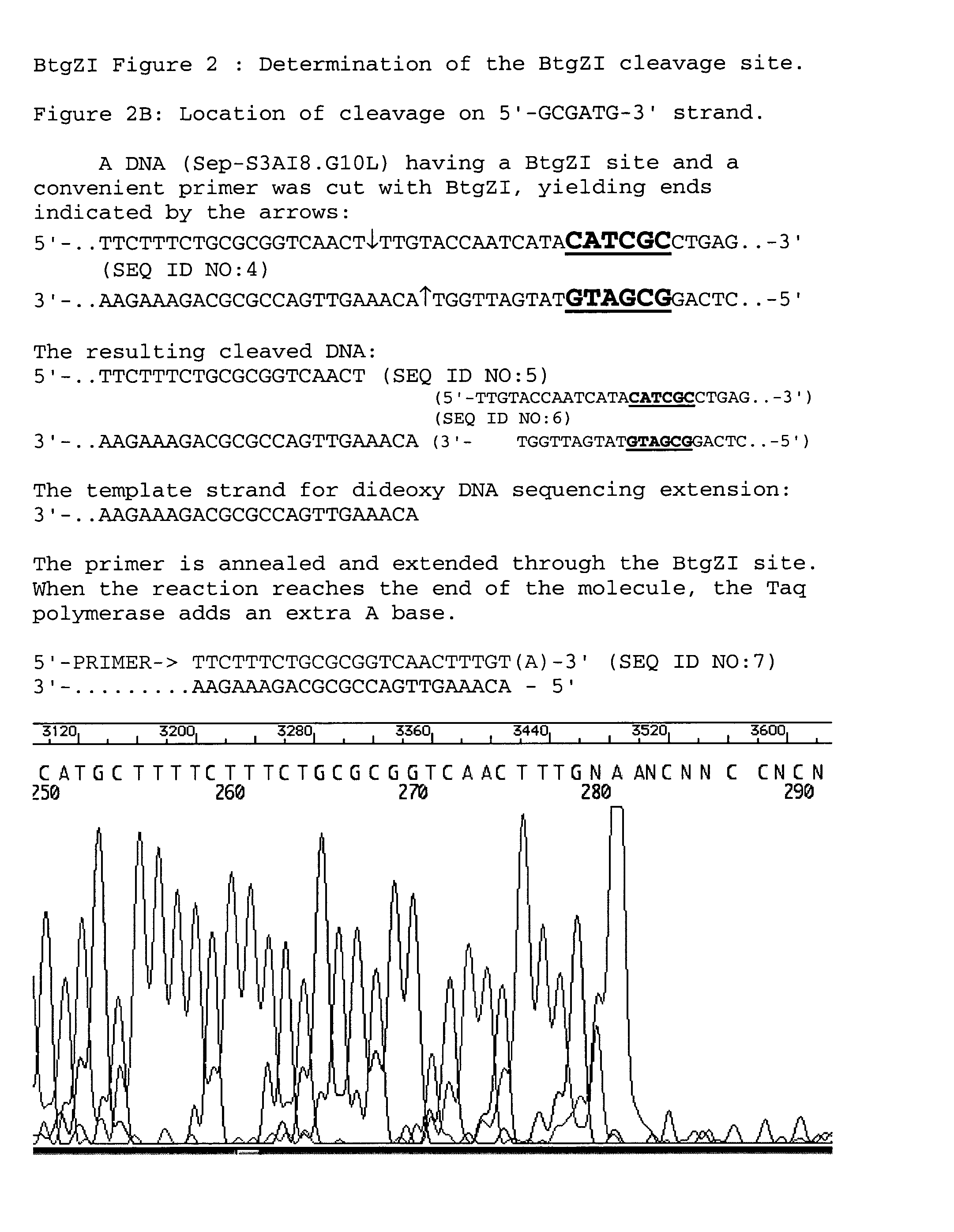Novel type II restriction endonuclease, BtgZI, obtainable from bacillus thermoglucosidasius 36A and a process for producing the same
a technology of restriction endonuclease and bacillus thermoglucosidase, which is applied in the field of new type ii restriction endonuclease, btgzi, obtainable from bacillus thermoglucosidase 36a, can solve the problem of dna being susceptible to further degradation by exonucleases
- Summary
- Abstract
- Description
- Claims
- Application Information
AI Technical Summary
Problems solved by technology
Method used
Image
Examples
example i
Production of BtgZI Endonuclease
[0028]Bacillus thermoglucosidasius 36A strain NEB#1384 was grown in Rich media (10 g Peptone, 5 g Yeast Extract, 5 g NaCl per liter.). The cells were incubated aerobically at 55° C. until late logarithmic stage (20 hours). The cells were then harvested by centrifugation and stored frozen at −70° C.
[0029] 248 grams of the cells obtained above were suspended in 744 mls buffer A (20 mM Tris-HCl, 0.1 mM EDTA, 10 mM beta-mercaptoethanol, 5% glycerol, pH 8.0 at 25 C) adjusted to 250 mM NaCl. The cells were lysed by four passes through a Gaulin press at 3000 psi, releasing approximately 50 mg of protein per gram of cells. The cell lysate was clarified by centrifugation at 15000×g by batch in a Sharples centrifuge. 1000 mls of supernatant was obtained containing approximately 11 g of soluble protein.
[0030] The supernatant solution was applied to a 500 ml DEAE Fast-Flow column (Amersham Biosciences, Piscataway N.J.) equilibrated in Buffer A adjusted to 250 ...
example ii
Determination of The BtgZI Cleavage Site
[0052] The location of BtgZI cleavage relative to the recognition sequence was determined by cleaving a suitable DNA molecule and then performing DNA sequencing from a suitable primer to the end of the cleaved DNA template. A plasmid DNA, PSEP.S3AI8.G10, consisting of a fragment of DNA isolated from an environmental sample inserted into the vector pUC19, into which the GPS2.1 transprimer (New England Biolabs) had been inserted, was employed as the template. This template was chosen because there were BtgZI sites in opposite orientations conveniently located at approximately 150 base pairs from the “North” priming site and 295 bases from the “South” priming site of the GPS system. Any sequenceable DNA that has a BtgZI site within several hundred base pairs of a priming site will work for this analysis, however, such as pBR322 DNA, if a suitable primer is available or is synthesized. The pSep.S3AI8.G10 plasmid DNA was cleaved with BtgZI by comb...
example iii
Determination of the BtgZI Amino Terminal Amino Acid Sequence
PUM
| Property | Measurement | Unit |
|---|---|---|
| pH | aaaaa | aaaaa |
| concentration | aaaaa | aaaaa |
| pH | aaaaa | aaaaa |
Abstract
Description
Claims
Application Information
 Login to View More
Login to View More - R&D
- Intellectual Property
- Life Sciences
- Materials
- Tech Scout
- Unparalleled Data Quality
- Higher Quality Content
- 60% Fewer Hallucinations
Browse by: Latest US Patents, China's latest patents, Technical Efficacy Thesaurus, Application Domain, Technology Topic, Popular Technical Reports.
© 2025 PatSnap. All rights reserved.Legal|Privacy policy|Modern Slavery Act Transparency Statement|Sitemap|About US| Contact US: help@patsnap.com



